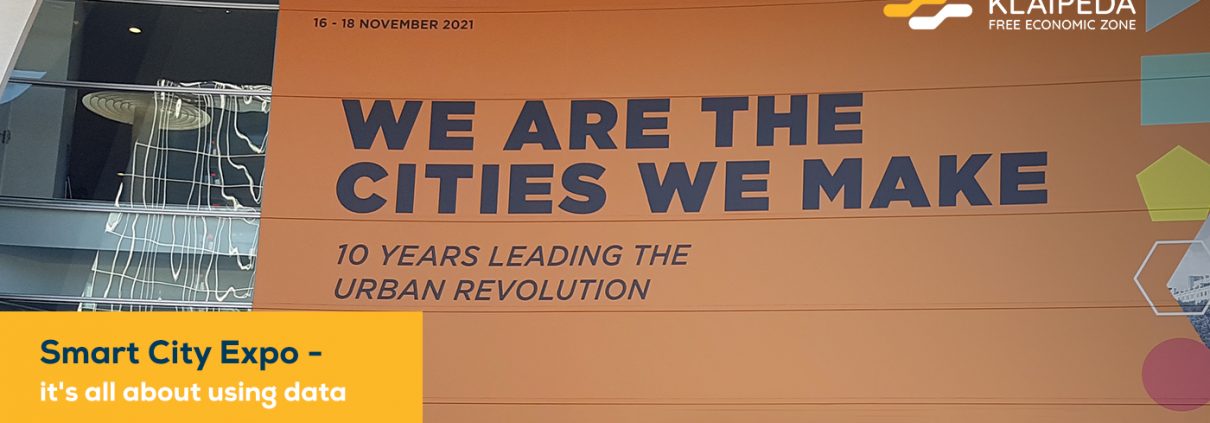Smart city trends: the data is in, it’s time to start using it
While a few years ago cities were looking to start collecting and organising data in general, now they are starting to think about what to do with it: how to use the information on traffic, weather, energy use or other information to solve problems and create better services. In November, these and other insights were brought back from the Smart City Expo in Barcelona by Karlas Impinnisi, innovation project manager at Klaipėda FEZ.
Klaipėda FEZ representatives have been interested in smart city trends for some time now for a simple reason. The FEZ territory is, in fact, still a “city within a city” with 6,000 employees and a unified infrastructure. Still, at the same time, it is an integral part of the city of Klaipėda, and is closely connected to the city’s ecosystem through social, traffic, engineering and other ties.
The Klaipėda FEZ Management Company has already implemented smart solutions such as an Internet of Things (IoT) network for various sensors, an odour monitoring and modelling system, a 3D model of the territory, and an automated system processes for certain data exchange or meter readings. The FEZ is also already deploying and is planning to launch smart traffic flow monitoring and parking systems in the spring. The development of a waste monitoring and management system is being considered and explored.
For these reasons, Mr. Impinnisi was in Barcelona to explore the latest trends in smart cities, technological and data solutions and possible partnerships.
One of the most striking aspects of this year’s event, he said, was the “digital twin cities,” i.e. the replication of cities or territories and the processes that take place in them on a virtual platform. This type of solution allows for a convenient digital representation of urban processes such as traffic and transport, construction and spatial planning, communications and infrastructure, etc.
“The value of digital twin cities lies in the ability to carry out a variety of process simulations before specific projects are undertaken and thus predict their positive or negative impact. For example, any impact of transport infrastructure or construction on human or vehicular traffic can be evaluated in a realistic way and decisions can be made accordingly. Digital twin cities allow cities to manage their resources more efficiently and to model new solutions in a safe, responsible and measured way,” says Mr. Impinnisi.
Another striking trend from Barcelona is data. While cities and territories around the world have been collecting data on traffic, traffic lights, air, waste, public transport and other urban services for some time, they are now starting to think about how to put this data into practice – to optimise existing services and to develop new ones. For example, properly prepared data is slowly being combined with artificial intelligence to model and predict relevant urban needs, to pre-empt problems, or find hard-to-see dependencies in systems. A simple example of this would be automated traffic and traffic light control, diverting traffic away from sources of pollution or, conversely, avoiding travel to more polluted areas.
Another striking trend this year is the monitoring of pollution and air quality. Cities around the world are increasingly focusing on the quality of life, the environment, problem prevention and real-time alerts, which is why the event showcased a wide range of technical solutions such as sensors, detectors, stations, systems and platforms. Of course, the exhibition was also full of solutions for electric or hydrogen-powered vehicles, solar energy, sustainable mobility and more.
According to Mr. Impinnisi, the trends at the Barcelona exhibition confirm the need to integrate existing technological solutions or data into common information platforms, harmonise technological standards, and share resources.
“Today, big and important decisions can be made with data. Therefore, it is important that as much data as possible is generally available and then properly organised, aggregated, analysed and, most importantly, used for decision-making. The Klaipėda FEZ is committed to an open approach to data, both within the territory and with city and regional partners – many of us already have a wide range of sensors and statistics, so it makes sense to combine all of this and see a single picture that will enable the city and individual organisations to make accurate, calculated and relevant decisions for the many,” says Mr. Impinnisi.

